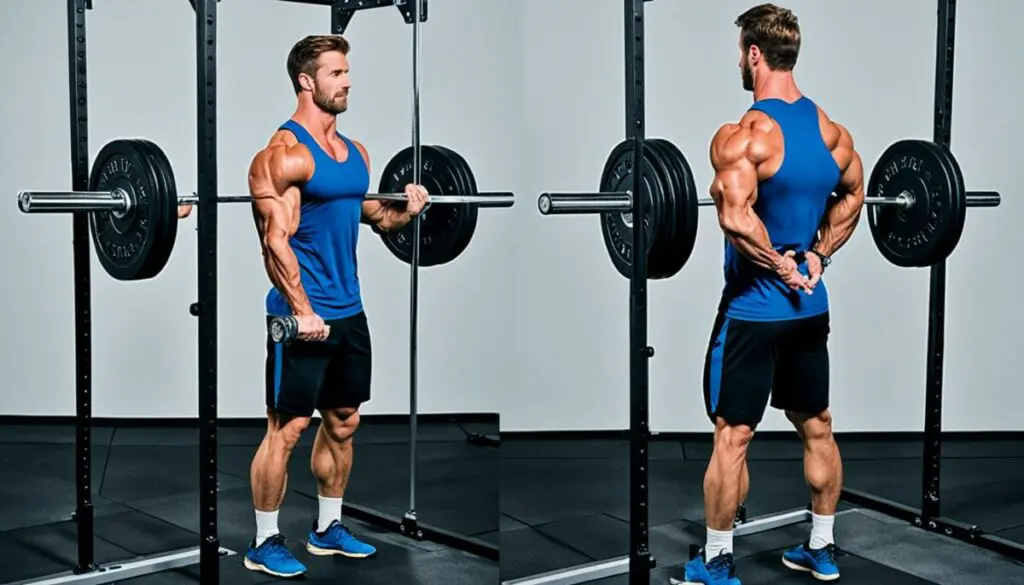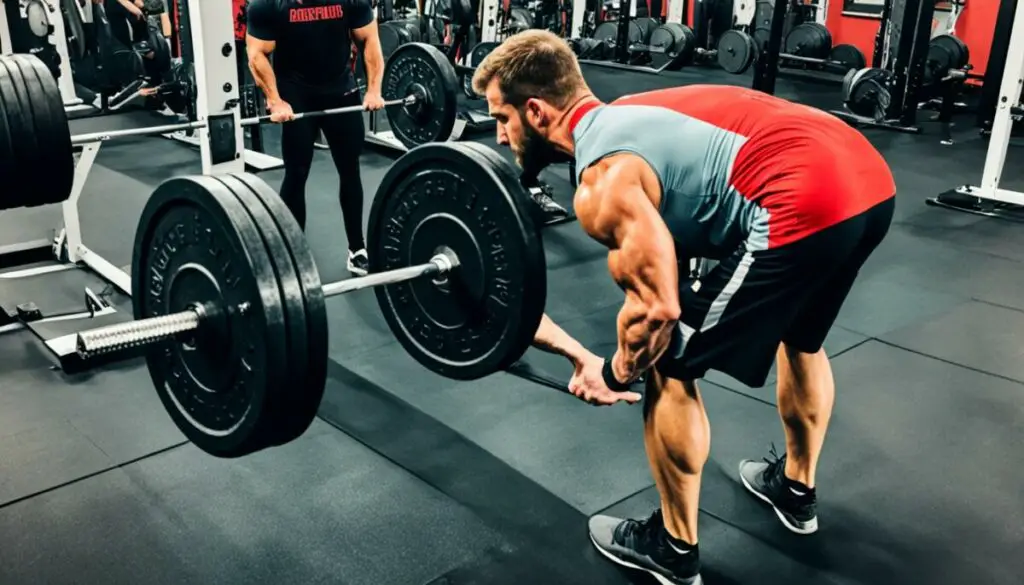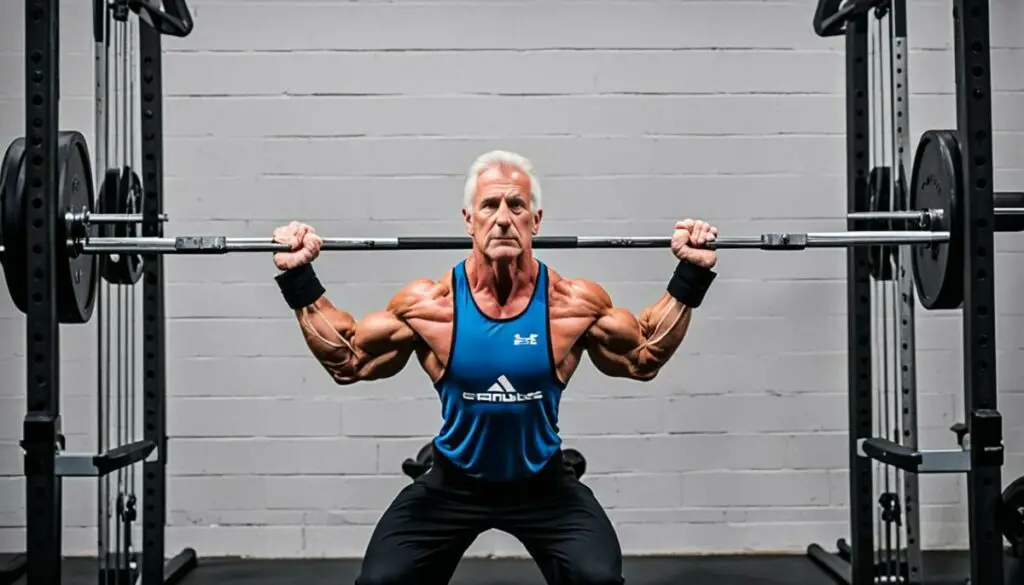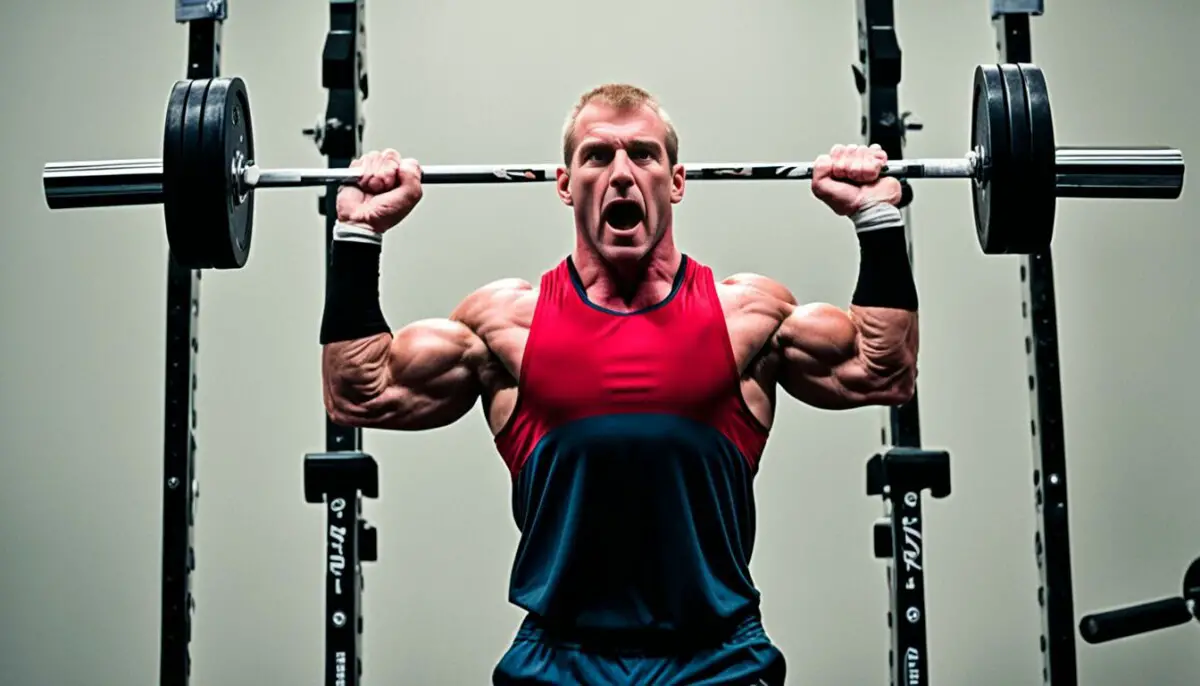Last Updated on 3 months by Francis
Welcome to our guide on mastering the deficit trap bar deadlift technique. Whether you’re a beginner looking to enhance your strength or an experienced athlete seeking to improve your technique, the deficit trap bar deadlift can be a valuable addition to your training routine. In this article, we will cover everything you need to know about this exercise, including the proper form, benefits, common mistakes to avoid, variations, and how to incorporate it into your training routine.
The deficit trap bar deadlift is a highly effective exercise that targets multiple muscle groups and improves overall fitness. By performing this exercise with proper form, you can enhance lower body strength, increase muscle mass, and improve pulling performance.
To get started on your deficit trap bar deadlift journey, it’s important to understand the proper form and technique. This will ensure that you maximize the benefits of the exercise and minimize the risk of injury. Let’s dive in!
Contents
Key Takeaways:
- Mastering the deficit trap bar deadlift technique can enhance strength and technique.
- The exercise targets multiple muscle groups and improves overall fitness.
- Proper form is crucial for maximizing the benefits and minimizing the risk of injury.
- Stay tuned for detailed instructions on how to perform the deficit trap bar deadlift correctly.
- Explore the variations of this exercise to add variety and challenge to your training routine.
How to Do the Deficit Trap Bar Deadlift

To perform the deficit trap bar deadlift, follow these step-by-step instructions:
- Start by assuming a hip-width stance with your toes pointed forward.
- Position your shoulders directly above the handles of the trap bar.
- Grip the bar tightly, ensuring a secure hold.
- Brace your core by engaging your abdominal muscles.
- Push the barbell straight downward, using the strength of your legs to initiate the movement.
- Avoid allowing your hips to rise faster than your shoulders, maintaining proper alignment.
- Stand up fully, extending your hips, knees, and ankles.
- Throughout the movement, keep your pelvis neutral, shoulders down and back, and distribute the load evenly across your body.
Remember to maintain proper form throughout the exercise to maximize its effectiveness and minimize the risk of injury.
Here’s an image of the deficit trap bar deadlift to help you visualize the proper form:
| Common Mistakes | Proper Form |
|---|---|
| Allowing hips to rise faster than shoulders | Keeping hips and shoulders aligned |
| Rounding the back | Maintaining a neutral spine |
| Using bent arms | Keeping arms straight |
| Bouncing the weight off the floor | Performing the movement with control |
| Poor knee-to-toe alignment | Maintaining proper knee positioning |
By mastering the proper form of the deficit trap bar deadlift, you can reap the full benefits of this exercise and avoid potential pitfalls.
Benefits of the Deficit Trap Bar Deadlift
The deficit trap bar deadlift offers several benefits. It is a great exercise for beginners to increase lower body strength and improve pulling performance. It also helps to develop foundational pulling strength and muscle mass necessary for deadlifting heavier loads. Additionally, it can be used as a supplemental lift for Olympic weightlifters and is ideal for decreasing lumbar stress. Moreover, the trap bar deadlift can increase leg and glute hypertrophy and allows for tactical overload.
Muscles Worked in the Deficit Trap Bar Deadlift

The deficit trap bar deadlift is a compound exercise that targets multiple major muscle groups, resulting in a well-rounded strength and muscle-building workout. When performing the deficit trap bar deadlift, the following muscle groups are primarily engaged:
| Muscle Group | Primary Muscle(s) Worked |
|---|---|
| Glutes | Gluteus maximus |
| Hamstrings | Biceps femoris, semitendinosus, semimembranosus |
| Quadriceps | Rectus femoris, vastus lateralis, vastus medialis, vastus intermedius |
| Erector Spinae (Lower Back) | Erector spinae muscles |
| Traps and Upper Back | Trapezius, rhomboids, rear deltoids |
The deficit trap bar deadlift also provides an emphasis on the quadriceps and glutes due to the more upright torso positioning. This exercise effectively strengthens the lower body and back muscles, helping to improve overall strength, power, and stability.
Furthermore, incorporating the deficit trap bar deadlift into your training routine can contribute to balanced muscle development and functional fitness. By targeting these key muscle groups, you can enhance your overall athletic performance and achieve your fitness goals.
Who Should Do the Deficit Trap Bar Deadlift

The deficit trap bar deadlift is a versatile exercise suitable for individuals of all fitness levels. Whether you’re a strongman, powerlifter, Olympic weightlifter, crossfit and fitness athlete, or starting your fitness journey, this exercise has something to offer. It serves as a valuable accessory movement for strongman training, a supplementary lift for powerlifters, and can even improve leg drive in the clean for Olympic weightlifters. Moreover, it adds variety to functional fitness programs and provides a safe and accessible posterior chain exercise for beginners.
Benefits for Different Athletes
- Strongmen: The deficit trap bar deadlift can help enhance overall strength and power, enabling strongmen to tackle heavy loads more effectively during competitions.
- Powerlifters: By incorporating the deficit trap bar deadlift into their training routine, powerlifters can target specific muscle groups, improve their deadlift form, and increase overall pulling strength.
- Olympic Weightlifters: This exercise can assist Olympic weightlifters in developing explosive leg drive during the clean, helping them to generate more power and lift heavier loads.
- Crossfit and Fitness Athletes: The deficit trap bar deadlift provides a functional movement pattern that translates well to the demands of crossfit and other fitness activities, enhancing overall strength and performance.
- Beginning Gymgoers: The deficit trap bar deadlift offers a safe and effective posterior chain exercise for beginners, helping them build a strong foundation of lower body strength and stability.
Sets and Reps for the Deficit Trap Bar Deadlift

The recommended sets and reps for the deficit trap bar deadlift depend on your training goals. Whether you’re a beginner looking to increase lower body strength or an experienced lifter aiming to improve pulling performance, tailoring your sets and reps is key to achieving optimal results.
For Beginners:
- Goal: Increase lower body strength and improve pulling performance
- Sets: 3-4 sets
- Reps: 8-10 repetitions
- Weights: Start with lighter weights
To build a solid foundation, performing 3-4 sets of 8-10 repetitions with lighter weights will help you develop the necessary strength and technique for the deficit trap bar deadlift. Focus on maintaining proper form throughout each rep as you gradually increase your strength and proficiency.
For Intermediate/Advanced Lifters:
- Goal: Improve overall strength and technique
- Sets: 3-5 sets
- Reps: 3-5 repetitions
- Weights: Use heavier weights
Once you have built a solid foundation, you can focus on heavier weights and lower reps to further improve your strength and technique. Performing 3-5 sets of 3-5 repetitions with heavier weights challenges your muscles and helps you progress in your deficit trap bar deadlift.
Remember, it is important to choose weights that challenge you while maintaining proper form. It’s always better to start with lighter weights and gradually increase the load as you become more comfortable and confident in the movement.
Common Mistakes in the Deficit Trap Bar Deadlift

When performing the deficit trap bar deadlift, it’s important to be aware of common mistakes that can hinder your progress and increase the risk of injury. By understanding these pitfalls and how to avoid them, you can optimize your performance and achieve better results.
- Allowing the hips to rise faster than the shoulders: One of the most common mistakes in the deficit trap bar deadlift is allowing the hips to shoot up before fully extending the legs. This can place excessive stress on the lower back and decrease the effectiveness of the exercise. Focus on maintaining a strong and balanced position throughout the movement, ensuring that the hips and shoulders rise together.
- Rounding the back: Another mistake to avoid is rounding the back during the deficit trap bar deadlift. This can compromise spinal alignment and increase the risk of injury. Keep your back straight and engage your core muscles to provide stability and support throughout the lift.
- Using bent arms instead of straight arms: Many people tend to bend their arms during the deficit trap bar deadlift, which places unnecessary strain on the biceps and detracts from the effectiveness of the exercise. To maintain proper form, focus on keeping your arms straight and using your lower body muscles to drive the movement.
- Bouncing the weight off the floor: Some individuals may use the momentum of a bounced weight to assist in the deficit trap bar deadlift. However, this reduces the effectiveness of the exercise and can lead to injury. Instead, aim for a controlled descent and ascent, maintaining tension and control throughout the entire range of motion.
- Improper knee-to-toe alignment: Maintaining proper knee-to-toe alignment is crucial during the deficit trap bar deadlift. Avoid allowing your knees to collapse inward, as this can strain the knees and compromise stability. Focus on keeping your knees in line with your toes throughout the movement.
By avoiding these common mistakes, you can perform the deficit trap bar deadlift safely and effectively, maximizing its benefits for strength, muscle development, and overall fitness.
Here’s a visual representation of the common mistakes in the deficit trap bar deadlift:
| Mistake | Correct Form |
|---|---|

|
Variations of the Deficit Trap Bar Deadlift
Looking to add some variety and challenge to your training routine? Try out these variations of the deficit trap bar deadlift. Each variation targets different muscle groups and provides a unique stimulus to maximize your training.
1. Deficit Trap Bar Deadlifts with High Handles:
By performing the deficit trap bar deadlifts with high handles, you can increase the range of motion and further engage your hamstrings and glutes. This variation is especially beneficial for individuals looking to develop posterior chain strength and improve their deadlift performance.
2. Deficit Trap Bar Deadlifts with Low Handles:
If you want to focus on quadriceps activation and emphasize leg drive, try deficit trap bar deadlifts with low handles. The lower starting position recruits the quad muscles more effectively and can help build strength in the front of your legs.
3. Deficit Trap Bar Deadlifts from an Elevated Platform:
Performing the deficit trap bar deadlifts from an elevated platform increases the deficit, requiring a greater range of motion and increased mobility. This variation helps to strengthen the lower back, glutes, and hamstrings, and it can also improve your conventional deadlift.
4. Deficit Trap Bar Deadlifts with Resistance Bands:
Using resistance bands during deficit trap bar deadlifts adds accommodating resistance, challenging your muscles throughout the entire lift. As the bands stretch, they provide a more significant challenge at the top of the movement, helping to develop explosive power and strength.
Remember to choose the variation that best aligns with your goals and fitness level. Incorporating these variations into your training routine can keep things interesting while targeting different muscle groups for a well-rounded strength and conditioning program.
Incorporating the Deficit Trap Bar Deadlift into Your Training Routine
To fully benefit from the deficit trap bar deadlift, it’s essential to incorporate it strategically into your training routine. There are various ways to integrate this exercise into your workouts, depending on your goals and preferences.
Main Deadlift Movement
The deficit trap bar deadlift can serve as your primary deadlift movement for building lower body strength and improving pulling performance. By focusing on this exercise, you can target multiple muscle groups while enhancing your technique and overall power.
Complementary Movements
To optimize your lower body strength, consider combining the deficit trap bar deadlift with other essential movements such as back squats, front squats, conventional deadlifts, or sumo deadlifts. These exercises can further develop your quads, hamstrings, glutes, and overall leg strength, creating a well-rounded training program.
Supplemental Lift
If your goal is to increase total body strength, incorporating the deficit trap bar deadlift as a supplemental lift can be highly effective. In this approach, you would perform the exercise after your main compound lifts, focusing on proper form and gradually increasing the weight to challenge your muscles and promote strength gains.
Accessory Exercise
The deficit trap bar deadlift can also be beneficial as an accessory exercise to support specific sports or fitness goals. For example, strongman athletes can use it to improve their posterior chain strength, while Olympic weightlifters can utilize it to enhance leg drive in the clean. By incorporating this exercise strategically, you can address specific weaknesses or imbalances in your training.
Remember to adjust the sets, reps, and weights based on your personal fitness level and goals. Gradually increase the intensity and workload over time to continue challenging your body and progressing towards your desired results.
| Training Routine Example | Sets | Reps | Rest |
|---|---|---|---|
| Deficit Trap Bar Deadlift (Main Movement) | 3 | 6-8 | 2-3 minutes |
| Back Squat | 3 | 8-10 | 2-3 minutes |
| Barbell Hip Thrust | 3 | 10-12 | 1-2 minutes |
| Lunge Variations | 3 | 12-15 | 1-2 minutes |
In this example, the deficit trap bar deadlift serves as the main movement, followed by complementary exercises such as back squats, barbell hip thrusts, and lunge variations. Adjust the sets, reps, and rest periods according to your fitness level and progression.
Conclusion
The deficit trap bar deadlift is a versatile and effective exercise that can significantly improve strength and technique. Whether you are a beginner or an experienced lifter, integrating this exercise into your training routine can yield numerous benefits for your overall fitness.
By performing the deficit trap bar deadlift with proper form, you can target multiple muscle groups, including the glutes, hamstrings, quadriceps, erector spinae, and upper back. This exercise not only strengthens these muscle groups but also helps to develop foundational pulling strength and improve pulling performance.
Furthermore, the deficit trap bar deadlift offers a variety of variations that can add diversity and challenge to your workouts. By exploring different variations and adjusting the sets, reps, and weights to match your fitness level and goals, you can continue to progress and maximize the benefits of this exercise.
Incorporating the deficit trap bar deadlift into your training routine can enhance your overall fitness, increase muscle strength, and improve your technique. Whether your aim is to build stronger legs, improve your deadlift, or enhance your athletic performance, the deficit trap bar deadlift is a valuable addition to your exercise repertoire.
FAQ
What is the proper form for the deficit trap bar deadlift?
To perform the deficit trap bar deadlift, start by assuming a hip-width stance with your toes pointed forward. Your shoulders should be directly above the handles of the trap bar. Grip the bar tightly and brace your core. Push the barbell straight downward with your legs, avoiding letting your hips rise faster than your shoulders. Stand up fully, maintaining a neutral pelvis, shoulders down, and evenly distributing the load throughout your body.
What are the benefits of the deficit trap bar deadlift?
The deficit trap bar deadlift is a great exercise for beginners to increase lower body strength and improve pulling performance. It helps to develop foundational pulling strength and muscle mass necessary for deadlifting heavier loads. Additionally, it can be used as a supplemental lift for Olympic weightlifters and is ideal for decreasing lumbar stress. The trap bar deadlift can increase leg and glute hypertrophy and allows for tactical overload.
Which muscle groups are worked in the deficit trap bar deadlift?
The deficit trap bar deadlift targets several major muscle groups, including the glutes, hamstrings, quadriceps, erector spinae (lower back), and traps and upper back. It effectively strengthens the lower body and back muscles while also providing an emphasis on the quadriceps and glutes due to the more upright torso positioning.
Who should do the deficit trap bar deadlift?
The deficit trap bar deadlift is suitable for individuals of all fitness levels. It is particularly beneficial for strongmen, powerlifters, Olympic weightlifters, crossfit and fitness athletes, and beginning gymgoers. It can be a valuable accessory movement for strongman training, a supplementary lift for powerlifters, and can help to improve leg drive in the clean for Olympic weightlifters. Additionally, it can add variety to functional fitness programs and provide a safe and accessible posterior chain exercise for beginners.
What are the recommended sets and reps for the deficit trap bar deadlift?
The recommended sets and reps for the deficit trap bar deadlift depend on your training goals. For beginners looking to increase lower body strength and improve pulling performance, 3-4 sets of 8-10 repetitions with lighter weights are recommended. To improve strength and technique, heavier weights can be used for lower reps, such as 3-5 sets of 3-5 repetitions. It is important to choose weights that challenge you while maintaining proper form.
What are some common mistakes to avoid in the deficit trap bar deadlift?
Some common mistakes to avoid in the deficit trap bar deadlift include allowing the hips to rise faster than the shoulders, rounding the back, using bent arms instead of straight arms, and bouncing the weight off the floor. It is also important to maintain proper knee-to-toe alignment and avoid inward knee collapse.
What are some variations of the deficit trap bar deadlift?
Some common variations of the deficit trap bar deadlift include deficit trap bar deadlifts with high handles, deficit trap bar deadlifts with low handles, deficit trap bar deadlifts from an elevated platform, and deficit trap bar deadlifts with resistance bands. These variations can target different muscle groups and provide different stimuli to maximize your training.
How can I incorporate the deficit trap bar deadlift into my training routine?
You can incorporate the deficit trap bar deadlift into your training routine by using it as a main deadlift movement for lower body strength and pulling performance. It can be performed alongside other lower body strength movements such as back squats, front squats, conventional deadlifts, or sumo deadlifts. It can also be used as a supplemental lift to increase total body strength or as an accessory exercise for specific sports or fitness goals. It is important to adjust the sets, reps, and weights to match your individual fitness level and goals.









